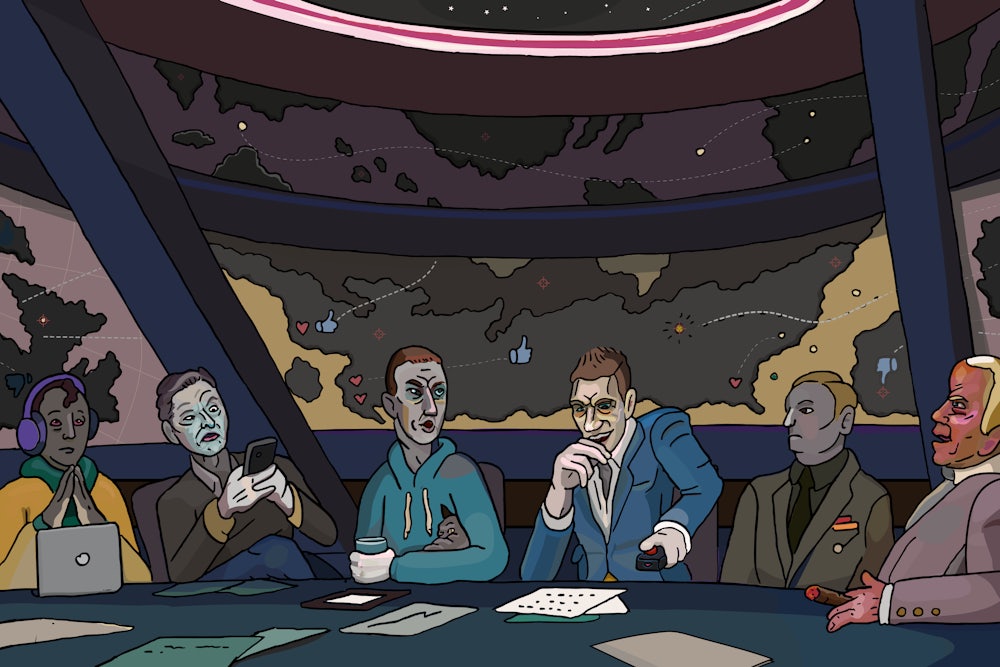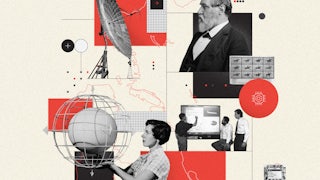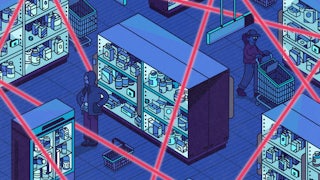It’s no coincidence that Stanford University was founded in Palo Alto, California, where many decades later scores of tech companies also got their start. Palo Alto is the birthplace of the “Palo Alto system,” an approach to training racehorses that attempted to speed up the process by applying techno-scientific principles and injecting lots of cash. This ethos of optimization, argues the writer Malcolm Harris, defined Stanford, which in turn helped define Silicon Valley and the ideology it has spread throughout the world. On episode 62 of The Politics of Everything, Laura Marsh and Alex Pareene talk with Harris about his new book, Palo Alto: A History of California, Capitalism, and the World; the tradition of right-wing thought that underpins the tech industry; and the dark marriage of tech and military power.
Malcolm Harris [clip]: How do you get from cool 1960s California to ’80s sucky California? How do you go from the cool stuff to Reagan, man? Like, what happened?
Laura Marsh: Silicon Valley likes to present itself as a fount of progress. In tech mythology, the personal computer and the internet ushered in a new era of openness and connectedness, of dot-com innovation and friendships rekindled on proto–social networking sites
Alex Pareene: But Silicon Valley’s actual origin story is murkier and less idealistic.
Laura: It begins in the town of Palo Alto: home to Stanford University, hub for the electronics industry, and birthplace of countless startups.
Alex: It spans horse breeding, the possible murder of one of Stanford’s founders, one of America’s worst presidents, and the Cold War boom in weapons.
Laura: Above all, the story of Palo Alto shows the persistence of right-wing thought that runs through Silicon Valley’s history.
Alex: Today on the show, we’re talking with author Malcolm Harris, whose new book, Palo Alto, tells the story of a town and the ideology it’s spread around the world. I’m Alex Pareene.
Laura: And I’m Laura Marsh.
Alex: This is The Politics of Everything.
Laura: Malcolm Harris’s new book, Palo Alto: A History of California, Capitalism, and the World is a deep dive into the culture and history of Palo Alto, from Leland Stanford’s arrival there in the nineteenth century and the founding of Stanford University through to PayPal and Facebook. One of Malcolm’s central questions is how the ideology that took hold in this place snowballed and reshaped the world we all live in today. Malcolm, thanks for joining us.
Malcolm Harris: Thank you so much for having me.
Laura: We have an image of Palo Alto today of affluence and innovation. The average home there is valued over $3 million. What was it like growing up in Palo Alto in the 1990s?
Malcolm: There’s no uniform experience, but the way I experienced it was so much like the suburban lives that I saw on television. I had two siblings. I had a dad who went to work in the morning and came home at night. I had a mom who was involved in the PTA and would pick my sisters up at school, a three-bedroom house—standard Boy Meets World–type reality. The way I experienced it was this protected bubble of American suburbia at a time when that model was in crisis around the country.
Alex: It sounds Spielbergian, practically.
Malcolm: Yeah, more or less.
Laura: There’s a story you tell in the book that feels like a little window into how the place imagined its own origins or its founding, where you describe kids at the school reenacting the California Gold Rush. Can you take us to that moment?
Malcolm: This is really common, in terms of California pedagogy. In fourth and fifth grade in particular, there’s a statewide standard to do California history, and one of the ways you do California history is you do the gold rush and, specifically, reenact the gold rush, where everyone plays settlers. Some teachers and staff literally went and hid little gold pieces throughout the school and then released us onto the schoolyard to go run and find these gold pieces that had been put there for us. After we found all the gold, we were supposed to develop an economy and sell things to each other and set up a social metabolism. It was this reenactment of primordial American, California capitalism—which was particularly notable for me because the year before, you reenact being indigenous inhabitants of the land. You’re smashing acorns into meal, experiencing what it was like to be indigenous in the area, and then the next year you’re the settlers and there’s no overlap between these periods. You pretend that you’re settling uninhabited land and the indigenous people from last year are all—
Alex: They graduated.
Malcolm: —well, it’s almost this Hegelian order of racist history. In the beginning, in second and third grade, you’re Indians, and then in fourth and fifth grade, you’re cowboys and settlers. And that’s how the history of man progresses. It’s racist in this very nineteenth-century way.
Laura: With the gold rush thing, it’s funny because I feel like you’re meant to be trained to experience the excitement of making enormous amounts of money and then making even more money by having that—which is of course, what adults were doing in this area at that time.
Malcolm: And they used the same metaphor the whole time. It was always the gold rush. It was the internet gold rush or the web gold rush, the Y2K gold rush.
Laura: In the book, you write that there was signs that if Palo Alto was normal, it was too normal, weirdly normal. Was there a moment you realized that something wasn’t quite right?
Malcolm: I do tell the story in the book about being a fourth grader and having a substitute teacher come to class and very frantically try to communicate to this group of Palo Alto 10-year-olds that Palo Alto was a special place in the world, that the rest of the world wasn’t like that, and we had to understand and try and see outside of our bubble. It was a very sci-fi experience for a 10-year-old to be told everyone is lying to you, your world isn’t the world. So that stuck with me, but I can’t say it revealed the world to be something that it wasn’t. It was learning about what this country was, learning about America during the George W. Bush years. And it wasn’t till later that I was able to really connect Palo Alto to these national–international trends.
Laura: Let’s talk about that a bit, because a big idea in the book is this idea of the “Palo Alto system.” How would you describe the ideology of the place?
Malcolm: The Palo Alto system starts as—and really is—this form of training horses, because Palo Alto starts as a horse stock farm owned by Leland Stanford, who’s the former governor, former head of the railroad, arch-oligarch of California. He starts training horses, and he wants to improve the capitalist function of training trotting horses. The problem with training trotting horses is it takes too much time. You have to feed these horses for so long, till their children achieve success racing-wise, because then you can sell their genetic material, so to speak. Leland Stanford said we’ve got do this faster, we’ve got to shorten the reproduction period of champion horses. He and his head trainer, Charles Marvin, developed what they called the Palo Alto system, based on early childhood education ideas that were coming out of Germany. We know them now as kindergarten: Put kids in school earlier, start training kids earlier. And they said, “We can apply these ideas to horses.” They start running these horses as fast as they can, as young as they can. They’re piling tons of capital and resources into the production of these young, speedy colts, and they take the whole horse-training world by storm. This proves that, if you apply ideas of science and technology and profit to millennia-old concepts such as the carriage horse, you can do something new: You can revolutionize these totally old systems as long as you are guided by science and profit. That’s the same idea that gets transferred into Stanford University and gets brought up over and over again by people in this place.
Alex: If you went around Stanford today, do you think people there know that the ideology of the place has its roots in, basically, horse kindergarten?
Malcolm: No one’s ever heard of the Palo Alto system referring to these colts. At the same time, if you start describing its premises—“It’s about scalability, being fast to market, and disrupting existing systems”—they’ll be like, “Oh yeah, the Palo Alto system. That’s what we do here.”
Alex: So Stanford establishes his eponymous university, and then he dies shortly after that. David Starr Jordan takes over. Can you give us the brief history of that and what Stanford the institution was meant to be as these men designed it?
Malcolm: It’s important to remember it as Leland Stanford Junior University. It’s named for Leland and Jane Stanford’s only son, Leland Stanford Jr., who died as a young teenager. He’s this incredibly promising young person who dies unexpectedly. His parents take the fortune that they were prepared to invest in their child and they say, literally, “The children of California will be our children.” When Leland Stanford Sr. dies, Jane Lathrop Stanford takes over the university, and she wants to build a center of philosophy and spiritualism as well as the biggest museum in the world. Doing this, she butt heads with David Starr Jordan, who’s the first president of the university, whom they brought in to lead it from Indiana. He’s a very scientific man of the time, which means for him that he’s very invested in eugenics—eugenics is the most important thing. They butt heads, and Jane Lathrop Stanford is ready to fire David Starr Jordan, she’s assembling all this evidence against him, she’s writing letters about how he’s going to be fired or whatever. And then Jane Lathrop Stanford is mysteriously poisoned. She survives the mysterious poisoning, gets on a boat, goes to Hawaii, says “I’m getting out of here. I’m scared for my life.” In Hawaii, she is mysteriously poisoned a second time and dies. Very, very suspiciously, David Starr Jordan says, “I’m a doctor”—he was a doctor of ichthyology—“and actually she definitely wasn’t poisoned. Absolutely no poisoning. Definitely not poisoned. Anyone who’s saying that she was poisoned is a liar. And it’s because it’s Hawaii, they’re probably savages.” There’s white retired doctors in Hawaii being like, “What are you talking about, dude, she’s obviously been poisoned to death.” In fact, she screams, “I’m being poisoned to death,” while she dies. Instead of being fired, David Starr Jordan becomes the president of Stanford University. So he’s really the one who gets to set up Stanford into what it becomes.
Laura: What interests of his, or what lasting achievements of his, do we still see in Stanford today?
Malcolm: He sets up this subject that he begins teaching with teachers that he recruits from Indiana called bionomics. Bionomics is the study of organisms in controlled environments, but it has all these eugenic precepts, and this idea of the order of organisms and the hierarchy of organisms and their improvement under controlled circumstances becomes the spiritual science of the school. One of the people that he recruits from Indiana is this guy Lewis Terman. Terman adapts an IQ test from France into what we know now as the Stanford–Binet IQ test, and really starts IQ testing as a sort of scientific expression of this bionomics that definitely persists into the current day.
Alex: The preoccupation with the optimization of all things is the dominant narrative of Stanford through the twentieth century.
Laura: After the break, we will be back to talk about how the Palo Alto system has shaped the culture of Silicon Valley over generations up to the present.
Laura: We are back with Malcolm Harris, author of Palo Alto. One thing I wanna talk about is what makes Stanford so important for understanding the wider world. Because you wouldn’t have written this book about Yale. It’s not just, “Oh, it’s an important university.” It’s at the center of an industry that’s reshaped the whole world.
Malcolm: Yeah, multiple industries. One of the agendas of Stanford from the beginning was to train students in high-tech fields such that they could become inordinately prominent in inordinately important fields and redound that importance onto the university. So these Stanford men are gonna go throughout the world and make Stanford important, and they’re gonna bring other Stanford guys with them, and they’re going to improve the reputation of Stanford all around the world. And this works right off the bat with Herbert Hoover, who’s part of the first class at Stanford University. He’s trained in mining engineering, and he goes around the world spreading Stanford thought.
Laura: It’s funny because I feel like there are a lot of big villains in the book. Every era of Palo Alto has a kind of really influential figure, whether it’s Leland Stanford or Herbert Hoover. And Herbert Hoover is not really remembered as a mining engineer; his legacy is being an incredibly bad president and then also the Hoover Institution at Stanford. Well, it’s not at Stanford, right? It’s near Stanford.
Malcolm: No, it is, it’s on Stanford.
Laura: Officially part of Stanford University?
Malcolm: People who want to … that’s all nonsense. It’s Stanford. They use these institutional distinctions very clearly in order to separate themselves from political consequences, but it’s fully integrated into Stanford.
Laura: So tell us about what the Hoover Institution is, where’s it come from, and what is it responsible for?
Malcolm: From the beginning when Hoover goes out in the world and starts making his fortune, he’s acclaimed by David Starr Jordan as the highest paid, youngest engineer in the world. He’s this celebrity tech guy, and he transfers pretty quickly into instead of being in all these mines all around the world, sitting in an office in London trading mining securities, and this whole time he’s sending funds back to Stanford. He builds the new student center, he’s building a bunch of stuff, and one of the things he builds becomes the Hoover War Library. If you look at the founding, the project is explicitly to combat Marxism in the world. This giant tower is where all the scariest right-wing thinkers of the twentieth century hung out all the time, and it continues to this day to give fellowships to freaky, freaky people—Milton Friedman, if we go back, or Austrian economics, some of the fringe ideologies of the later part of the twentieth century come out of this institution. It was built for precisely this reason, to promote these ideas.
Laura: By this point in the history of Palo Alto, Stanford, you’ve got not only a strong emphasis on traditional industrial capitalism and eugenics, but now also this very, very fierce anti-communism. And those are kind of the ingredients of the place up to that point.
Malcolm: It becomes this anti-communist bastion. And then when World War II is over, you’ve got a place where they’re figuring out the devices that America is going to need to use to maintain its position in the post-war environment when anti-colonialism is on the march. The way I look at it is that the question of the twentieth century is the question of total equality. If the world is integrated into one big place and liberal ideas developed in the nineteenth century such that equality is on everyone’s mind, how can you stop the march of equality of all peoples in the world? Because Palo Alto at that point has got a lot invested in stopping that march. It is a suburb built to secure the future for people who have inordinate power in Anglo-America. And what they come up with is missile Keynesianism, which is to say, “We’re going to make a bunch of money by building a bunch of bombs and dropping it on a lot of the world.”
Alex: I feel like we think of Silicon Valley in terms of the birth of the microchip, but not so much as a place that was invested in building weapons.
Malcolm: If you look at what a nuclear missile is made out of, you think, “Oh, it’s a big metal shell, and it’s probably made in L.A. or somewhere.” And then there’s the nuke stuff, and that’s made at a lab in Berkeley or L.A. But you don’t think about the micro ships, which are crucial. The first generation of silicon ships goes into the Minuteman I nuclear missile, and you don’t think about the testing instruments which are used to make the electronics and build the whole thing. So much of these nuclear missiles is coming directly out of Palo Alto, and Palo Alto has been looking for for decades for solutions to this problem of the potential of equality of all people. That’s what the eugenicists were trying to answer in advance. So it’s not a coincidence that these technologies come out of Palo Alto. Palo Alto’s been trying to figure out how we become so powerful that we can justify our position in the world, or at least just defend it.
Alex: There’s some irony in your missile Keynesianism going hand in hand with Palo Alto and Stanford’s anti-communism, because it depended on huge amounts of federal money to keep the system going.
Malcolm: Well, you’ve got to remember, Palo Alto’s favorite son is Herbert Hoover. He becomes not just president of the United States, but commerce secretary for two terms before that. And as commerce secretary, he’s rearranging so much of how the federal government works, under the idea that what the federal government should really be about is bringing together economic stakeholders, the ownership class, to figure things out together in an associative model—sort of the ultimate cartel. He’s running a giant federal bureaucracy and he’s constantly bringing in new things into his remit. He’s bringing military spending into commerce, and industrial policy all centered around the military. And Vannevar Bush, who’s known for coming up with American industrial tech policy, is a Hoover guy. He goes on to found Raytheon at MIT, but he’s a Hoover loyalist and he’s the one who sets up the federal funding for tech development. So I think there’s a danger to say, “Oh, they’re anti-communists, they’re anti-socialist, they’re anti-FDR, therefore, they don’t want anything to do with the federal government.” The federal government’s job is to facilitate what they’re doing. It’s the governance of the milieu, the governance of the cartel, the governance of the cabal, the governance of the gang. The associative model is what historians call it, referring to the Hoover administration. But again, we still see this when you see Donald Trump and Peter Thiel organizing a meeting with all the big tech heads—Jeff Bezos is sitting there, and Cheryl Sandberg, and Larry whatever, they’re all sitting around a table and then after that meeting, those tech companies start applying for Prime DoD contracts for the first time. That’s the associative model. That’s Hoover par excellence, and Trump in that meeting is like, “Whatever I can do to help you guys in industry to make this tech thing go long, I’m gonna do it.” And that, for them, is what governance is all about.
Alex: One of the founding myths of the tech industry in Silicon Valley is a sort of countercultural one, in which they are hippies and rebels. You’re describing the associative model—they’re people who’ve worked hand in glove with the government, the military industrial complex, people who’ve worked with the far right for years and years comfortably. That sort of counter-cultural myth, what purpose does it serve? How does it get invented? And to what extent is it false or true?
Malcolm: It’s the dominant narrative for how we understand this history. The transition from how you get from the cool 1960s in California to the ’80s sucky California? How do you go from the cool stuff to Reagan, man? What happened? Some people tell this narrative as “We did it all.” The narrative of “The Grateful Dead’s lyricist invented the internet.” This is a popular story for people who are tech utopians or tech-positive, people who are like, “We were on the right side both times. We were against all this—Vietnam, oppressive government stuff—and then we came up with the internet and we saved America.” This has been the dominant narrative of the Internet’s production. You have the critical version of that also, with the Californian ideology, where they say, “Both were bad. The hippies were bad and the ’80s were bad. They did do that. It was the hippies, they were anti-government and individualists, and that individualism created this neoliberal economy.” I was prepared to write a version of that narrative, but the more and more I worked on it, the more I saw that as really just branding that had very little to do with what was going on in the world. The main thing that was going on in the world was the Cold War, and then these guys were trying to pretend like they weren’t involved. Meanwhile, they were mostly very involved, often working for the American government doing war work, maybe doing drug research on behalf of the defense department, maybe making ARPANET whatever, but mostly building nuclear missiles. The fact that none of those nuclear missiles ever blew up the world means they get to tell this story about how they were hippies or whatever. But you can’t be a hippie and build nuclear missiles all day. Or you can, but if you’re a hippie building nuclear missiles all day, then clearly your hippieness or your ideas about yourself or your ideas about the world are not what’s important—it’s the missiles that are important. If you read the Californian ideology, they say the new left was pro-technology, straight up. But then if you actually look at what the new left did, they tried to blow up every computer in the country. Every university in the country that had a computer center was under high alert because radical students on campus were trying to blow them up. We almost never talk about the SDS actually bombing the Pentagon and taking down airborne targeting over Vietnam for two weeks because it doesn’t fit with this “The hippies invented the internet story”—because they weren’t hippies, they were militant communists who were going around bombing all the computers they could because they understood that as the weakest point in the American war machine.
Laura: There are two sides to this, though, that are weird. Because you have the people telling the kind of internet-and-hippie story, but then the other part of it is that the right has never really come out and been like, “Oh no, we actually invented it and we’re pulling all the strings and we are doing all of this stuff,” which is kind of the story your book is tracing. Like there’s always been a very, very strong right-wing foundation to Silicon Valley, and yet they haven’t really been that eager to—until recently, where you have more openly right-wing figures like Peter Thiel and Elon Musk in the public, and particularly Elon Musk—be out there saying, “Hey, we have right-wing views, and we’re also in charge of all the tech companies.”
Malcolm: One of the things I was a little surprised to see was how mixed the tech industry was on the 2000 election, on Bush v. Gore—we think of that era of tech as very liberal.
Laura: It’s really dominated by very young people, too.
Malcolm: Exactly. But Bush had a whole ream of high-profile tech industry supporters, especially at the high levels on some of these companies. Their slogan was B2K, which I think is kind of funny.
Laura: Wait, business 2000? What’s the B stand for?
Malcolm: Bush 2000. B2K.
Laura: Right, right.
Alex: Well, that’s funny also, because Gore was not just the person who was mocked for saying he took the initiative for creating the internet, but was in many respects the result of years and years of the Democrats courting the tech industry and very purposefully aligning themselves with big tech, beginning in the ’80s and throughout the Clinton administration, and yet still…
Malcolm: Atari Democrats is what they were called, both because they came up on Atari and because they had taken more of a free-market approach toward economics. Part of the hippie story is that the kids of these hippies were the Atari Democrats. That’s what Clinton–Gore was, right on the edge.
Laura: It’s kind of this idea that tech is fun and liberals are the fun ones and the right isn’t fun and all these labels seem to stick to Democrats more than they stick to the right. No one is still talking about B2K, but people do remember the Atari Democrats.
Malcolm: Which is funny, because then when you look at after Bush won and how tech is feeling and what their commentary is, they are so excited. The thing they’re most excited about is John Ashcroft being named attorney general.
Alex: Oh my God, yeah.
Malcolm: For anyone who’s from the Bush administration era, John Ashcroft has a very, very, very specific meaning for us because he was public enemy number one—he was the villain for liberals and lefties, and you’d think for tech too, because he was so associated with the disintegration of privacy rights, which tech was supposed to hold sacred, as well as a sort of Christian conservatism that the tech milieu was supposed to be a threat to, like “We are the poly-pagan rave people or whatever. We don’t want the Christian dad being in charge”—but they did. They loved John Ashcroft, and John Ashcroft loved tech, too. Always pro-tech, always pro-internet. And the deal he came up with with tech was, “I’ll drop the Microsoft antitrust suit, I’ll let you guys basically set up whatever sort of regulation by clicking an ‘I accept’ button.” That was a product of the Ashcroft years, the “I accept” terms and conditions button as opposed to limiting what internet services could do and how they would interact with their services. There’s a “Look, if you get them to accept, then that’s fine,” The deal was that then those internet providers would sell the government access to all this information that otherwise the government would be prevented from accessing because of privacy rights, and the government could just be another client for these private services.
Laura: It’s funny because reading your book, the current generation of prominent tech leaders—people like Thiel and Musk who are more openly right-wing—make a lot more sense. They seem more like just one in a very long line of people with similar beliefs, especially Peter Thiel, because he was actively involved in the ideological cultures of Stanford, The Stanford Review. I think he had fellowships at the Hoover Institution. They don’t seem like a new kind of guy.
Malcolm: No, not at all. Thiel’s part of the board of overseers for the Hoover Institution. So he picks up this job. But it’s not just from Hoover to Thiel, we’ve got David Packard in the middle, who’s understood as one of the founders of Silicon Valley.
Laura: He is the P in HP.
Malcolm: He’s the P in HP. David Packard, is a six-foot-five Stanford football player, golden boy, the administration consciously supports him. He has to drag Hewlett along because they don’t like Hewlett as much because he’s not six-five. But David Packard isn’t just conservative. He isn’t just a member of the Hoover Board of Overseers, which is huge. He doesn’t just personally save the American Enterprise Institute, which becomes one of the most important conservative institutions of the past decades and which he personally rescues with his own fortune. He’s also deputy secretary of defense for Nixon during Vietnam. He’s part of the federal bureaucracy. And then Reagan, of course, becomes president, and he’s very, very closely associated with the Hoover Institution and with the Stanford conservative milieu. They put his picture in all their offices before he’s president. He’s their great hope.
Laura: How important is tech really in this story? Because in some ways it’s a very traditional story of holding power in extremely traditional ways: being in the government and then fostering ideology and perpetuating it through think tanks and sponsoring fellowships and papers to be written that support your views and the policies that you want. That’s all low-tech stuff.
Malcolm: Well, when I started this project, or, I think, when most people think about Silicon Valley and they’re like, “What is the iconic product of Silicon Valley?” they think the personal computer, maybe they think the silicon transistor. But when I look at the history and think about what was the product of Palo Alto, it was the nuclear missile. It was a cocked gun put to the world’s head that said, “If America falls, we’re gonna blow the world’s brains out.” That’s what the project of Palo Alto’s tech is. We think about the Internet’s early usage as connecting people with friends that they didn’t know before. The Internet’s early usage was running Iran–Contra. It was running radio systems out of the Panama Canal zone to organize massacres throughout Latin America in order to win the Cold War.
Alex: It wasn’t just looking up Monty Python lyrics on Gopher? There was more to it than that?
Malcolm: It was really categorizing future murder victims. That’s what these things were doing. And they spent a lot of time saying, “Well, computers can be used for a lot of things. If we want to export them to Idi Amin or we want to export them to the shah, then they’re probably just using it for weather monitoring or whatever.”
Laura: All of that stuff that we think of the Internet—that’s the branding that’s extremely successful. We think, “Oh yeah, like Friendster and Myspace and Grooveshark, or these foundational internet companies”—and actually, they’re just sort of the side dressing.
Malcolm: And when you think about the earliest laptops, what were the earliest laptops used for? Well, they were used for covert agents abroad plugging into encrypted networks so they could talk to Oliver North and run a shadow government policy with 15 dudes throughout the world with no oversight. That’s not easy. That requires this new kind of communicative technology. And that’s what the internet was.
Alex: Wow. Well, that was the killer app, would you say, Malcolm?
Malcolm: It really was. The Cold War was the killer app.
Alex: All right, Malcolm, thank you so much for talking to us today. The book is great, by the way.
Malcolm: Thanks so much for having me, guys.
Laura: Malcolm Harris’s new book, Palo Alto: A History of California, Capitalism, and the World is out now.
Alex: The Politics of Everything is co-produced by Talkhouse.
Laura: Emily Cooke is our executive producer.
Alex: Lorraine Cademartori assisted on this episode.
Laura: Myron Kaplan is our audio editor.
Alex: If you enjoy The Politics of Everything and you want to support us, one thing you can do is rate and review the show. Every review helps.
Laura: Thanks for listening.








